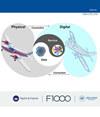TAD-Net:一种基于时间卷积网络和图卷积网络的数字双车间实时动作检测方法
引用次数: 5
摘要
背景:对生产过程中人的行为进行智能监控是实现生产流程标准化、快速构建数字化孪生车间的重要一步。人的行为对车间的生产安全和生产效率有着重要的影响,但由于人的个体能动性高,在数字孪生车间中很难实现实时的行为检测。方法:提出一种车间生产动作实时检测方法。该方法使用连续的人体骨骼关节序列数据作为输入。然后,我们基于时间卷积网络(TCN)和图卷积网络(GCN)重构了联合分类回归递归神经网络(JCR-RNN)。我们将这种方法称为时间动作检测网(TAD-Net),它实现了车间生产动作的实时检测。结果:验证实验结果表明,我们的方法在现有的在线动作检测(OAD)数据集和南京理工大学3维(NJUST3D)数据集上取得了较高的时间定位分数、识别速度和准确率。TAD-Net可以满足数字孪生车间的实际需要。结论:与其他主流网络模型相比,该方法具有更高的识别精度、时间定位精度和更快的运行速度,能够更好地满足实际应用需求,对于规范车间生产流程、降低生产安全风险、理解实时生产动作具有重要的研究价值和现实意义。本文章由计算机程序翻译,如有差异,请以英文原文为准。
TAD-Net: An approach for real-time action detection based on temporal convolution network and graph convolution network in digital twin shop-floor
Background: Intelligent monitoring of human action in production is an important step to help standardize production processes and construct a digital twin shop-floor rapidly. Human action has a significant impact on the production safety and efficiency of a shop-floor, however, because of the high individual initiative of humans, it is difficult to realize real-time action detection in a digital twin shop-floor. Methods: We proposed a real-time detection approach for shop-floor production action. This approach used the sequence data of continuous human skeleton joints sequences as the input. We then reconstructed the Joint Classification-Regression Recurrent Neural Networks (JCR-RNN) based on Temporal Convolution Network (TCN) and Graph Convolution Network (GCN). We called this approach the Temporal Action Detection Net (TAD-Net), which realized real-time shop-floor production action detection. Results: The results of the verification experiment showed that our approach has achieved a high temporal positioning score, recognition speed, and accuracy when applied to the existing Online Action Detection (OAD) dataset and the Nanjing University of Science and Technology 3 Dimensions (NJUST3D) dataset. TAD-Net can meet the actual needs of the digital twin shop-floor. Conclusions: Our method has higher recognition accuracy, temporal positioning accuracy, and faster running speed than other mainstream network models, it can better meet actual application requirements, and has important research value and practical significance for standardizing shop-floor production processes, reducing production security risks, and contributing to the understanding of real-time production action.
求助全文
通过发布文献求助,成功后即可免费获取论文全文。
去求助
来源期刊

Digital Twin
digital twin technologies-
自引率
0.00%
发文量
0
期刊介绍:
Digital Twin is a rapid multidisciplinary open access publishing platform for state-of-the-art, basic, scientific and applied research on digital twin technologies. Digital Twin covers all areas related digital twin technologies, including broad fields such as smart manufacturing, civil and industrial engineering, healthcare, agriculture, and many others. The platform is open to submissions from researchers, practitioners and experts, and all articles will benefit from open peer review.
The aim of Digital Twin is to advance the state-of-the-art in digital twin research and encourage innovation by highlighting efficient, robust and sustainable multidisciplinary applications across a variety of fields. Challenges can be addressed using theoretical, methodological, and technological approaches.
The scope of Digital Twin includes, but is not limited to, the following areas:
● Digital twin concepts, architecture, and frameworks
● Digital twin theory and method
● Digital twin key technologies and tools
● Digital twin applications and case studies
● Digital twin implementation
● Digital twin services
● Digital twin security
● Digital twin standards
Digital twin also focuses on applications within and across broad sectors including:
● Smart manufacturing
● Aviation and aerospace
● Smart cities and construction
● Healthcare and medicine
● Robotics
● Shipping, vehicles and railways
● Industrial engineering and engineering management
● Agriculture
● Mining
● Power, energy and environment
Digital Twin features a range of article types including research articles, case studies, method articles, study protocols, software tools, systematic reviews, data notes, brief reports, and opinion articles.
 求助内容:
求助内容: 应助结果提醒方式:
应助结果提醒方式:


